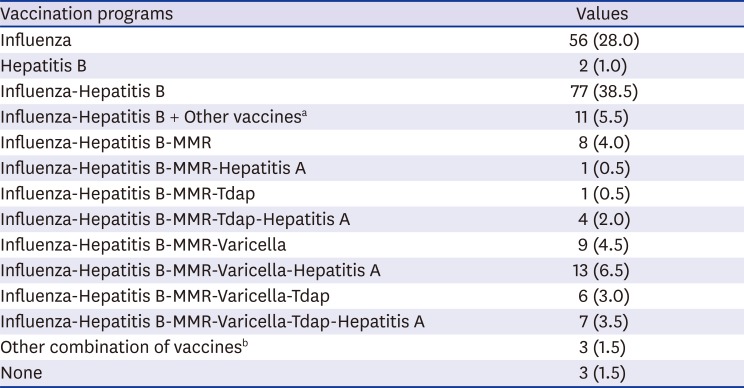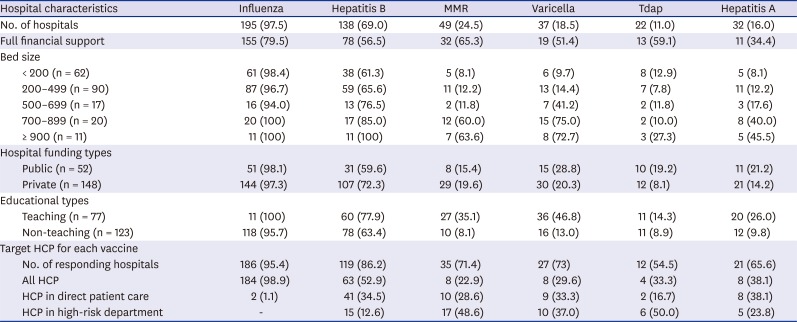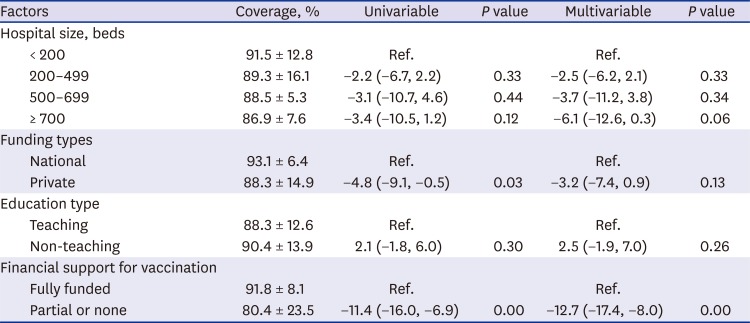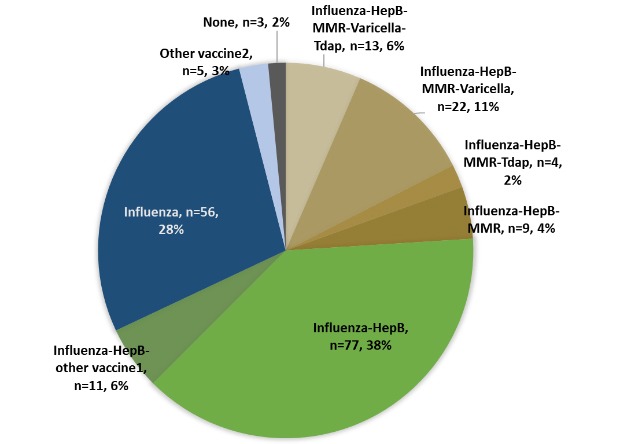1. Sydnor E, Perl TM. Healthcare providers as sources of vaccine-preventable diseases. Vaccine. 2014; 32(38):4814–4822. PMID:
24726251.

2. Yun JW, Noh JY, Song JY, Chun C, Kim Y, Cheong HJ. The Korean Influenza National Immunization Program: history and present status. Infect Chemother. 2017; 49(4):247–254. PMID:
29299891.

3. Korea Centers for Disease Control and Prevention. National Childhood Vaccination Coverage among Children Aged 3 Years in Korea, 2016. Cheongju, Korea: Korea Centers for Disease Control and Prevention;2017.
4. Choi WS, Sniadack DH, Jee Y, Go UY, So JS, Cho H, et al. Outbreak of measles in the Republic of Korea, 2007: importance of nosocomial transmission. J Infect Dis. 2011; 204 Suppl 1:S483–S490. PMID:
21666204.

5. Shin NR, Choi S, Jung YH, Kim H, Jung CW, Om J, et al. Measles outbreak and response from December 2018 to May 2019. Public Health Wkly Rep. 2019; 12(30):1016–1025.
6. Chang HH, Kim SW, Kwon KT, Kim HI, Kim MJ, Ryu SY, et al. Preliminary report of seroprevalence of anti-measles immunoglobulin G among healthcare workers of 6 teaching hospitals of Daegu, Korea in 2019. Infect Chemother. 2019; 51(1):54–57. PMID:
30941938.

7. Choi WS, Kim SH, Park DW. Seroprevalence of pertussis in healthcare workers without adult pertussis vaccine use at a university hospital in Korea. J Korean Med Sci. 2018; 33(50):e321. PMID:
30534033.

8. Korea Centers for Disease Control and Prevention. Guidelines for Adult Immunization. 2nd ed. Cheongju, Korea: Korea Centers for Disease Control and Prevention;2018.
9. Ko K, Kim S, Kim SH, Son KY, Lee J, Lee DR. Knowledge, current status, and barriers toward healthcare worker vaccination among family medicine resident participants in a web-based survey in Korea. Korean J Fam Med. 2017; 38(1):21–27. PMID:
28197329.

11. Shin BM, Yoo HM, Lee AS, Park SK. Seroprevalence of hepatitis B virus among health care workers in Korea. J Korean Med Sci. 2006; 21(1):58–62. PMID:
16479066.

12. Kang JH, Park YS, Park SY, Kim SB, Ko KP, Seo YH. Varicella seroprevalence among health care workers in Korea: validity of self-reported history and cost-effectiveness of prevaccination screening. Am J Infect Control. 2014; 42(8):885–887. PMID:
25087140.

13. Jung J, Kim SK, Kwak SH, Hong MJ, Kim SH. Seroprevalence of measles in healthcare workers in South Korea. Infect Chemother. 2019; 51(1):58–61. PMID:
30941939.

14. Fiebelkorn AP, Redd SB, Kuhar DT. Measles in healthcare facilities in the United States during the postelimination era, 2001–2014. Clin Infect Dis. 2015; 61(4):615–618. PMID:
25979309.
15. Botelho-Nevers E, Gautret P, Biellik R, Brouqui P. Nosocomial transmission of measles: an updated review. Vaccine. 2012; 30(27):3996–4001. PMID:
22521843.

16. Park SH, Lee DH, Jin JY, Shin YL, Shin M, Kim SS, et al. Measles outbreaks in the Kyeongin area of the Republic of Korea, 2013–2014: a single-center experience in a country of measles elimination. Asian Pac J Trop Med. 2017; 10(1):69–74. PMID:
28107869.

17. Dolan SB, Libby TE, Lindley MC, Ahmed F, Stevenson J, Strikas RA. Vaccination policies among health professional schools: evidence of immunity and allowance of vaccination exemptions. Infect Control Hosp Epidemiol. 2015; 36(2):186–191. PMID:
25633001.

18. Korea Centers for Disease Control and Prevention. Guidelines for Adult Immunization. 1st ed. Cheongju, Korea: Korea Centers for Disease Control and Prevention;2012.
21. Byeon KH, Kim J, Choi B, Choi BY. The coverage rates for influenza vaccination and related factors in Korean adults aged 50 and older with chronic disease: based on 2016 Community Health Survey data. Epidemiol Health. 2018; 40:e2018034. PMID:
30056640.

22. Yue X, Black C, Ball S, Donahue S, De Perio MA, Laney AS, et al. Workplace interventions associated with influenza vaccination coverage among health care personnel in ambulatory care settings during the 2013–2014 and 2014–2015 influenza seasons. Am J Infect Control. 2017; 45(11):1243–1248. PMID:
28684126.

23. To KW, Lai A, Lee KC, Koh D, Lee SS. Increasing the coverage of influenza vaccination in healthcare workers: review of challenges and solutions. J Hosp Infect. 2016; 94(2):133–142. PMID:
27546456.
24. Jung Y, Kwon M, Song J. Stepwise intervention including 1-on-1 counseling is highly effective in increasing influenza vaccination among health care workers. Am J Infect Control. 2017; 45(6):635–641. PMID:
28063732.









 PDF
PDF Citation
Citation Print
Print




 XML Download
XML Download